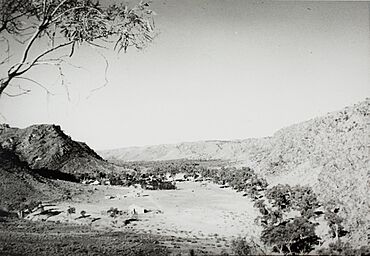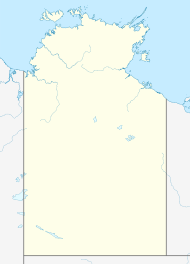Areyonga, Northern Territory facts for kids
Quick facts for kids AreyongaNorthern Territory |
|||||||||||||||
|---|---|---|---|---|---|---|---|---|---|---|---|---|---|---|---|

Areyonga settlement in the Northern Territory of Australia (circa 1958)
|
|||||||||||||||
| Population | 236 (2021 census) | ||||||||||||||
| Established | 1920s | ||||||||||||||
| Postcode(s) | 0872 | ||||||||||||||
| Time zone | ACST (UTC+9:30) | ||||||||||||||
| Location |
|
||||||||||||||
| LGA(s) | MacDonnell Region | ||||||||||||||
| Territory electorate(s) | Gwoja | ||||||||||||||
| Federal Division(s) | Lingiari | ||||||||||||||
|
|||||||||||||||
| Footnotes | Adjoining localities | ||||||||||||||
Areyonga (which is called Utju in the Pitjantjatjara language) is a small town in the Northern Territory of Australia. It is located about 220 kilometers (137 miles) west of Alice Springs. The town was started in the 1920s. In the 2021 Australian census, about 236 people lived there. Most of them are Aboriginal people from the Pitjantjatjara language group.
Areyonga School was one of the first schools to use "two-way education". This special way of learning teaches both traditional Aboriginal culture and modern school subjects. It celebrated its 50th anniversary in June 2023.
Contents
History of Areyonga
Areyonga was founded in the 1920s. A very long drought (a time with no rain) made many Pitjantjatjara families leave their homes in the Petermann Ranges. They first moved to Hermannsburg. Then, they created a new community at Areyonga.
A Lutheran mission (a place run by a church group) was set up in Areyonga in the 1940s. In the 1970s, many people from the mission moved back to their old community. The Lutheran mission in Areyonga closed in 1990. The land was then given back to the local Aboriginal people.
Location and How to Get There
Areyonga is about 220 kilometers (137 miles) west of Alice Springs. It sits in a valley at the end of the MacDonnell Ranges. The town is at the bottom of a beautiful, deep gorge.
The area around Areyonga has lots of plants and animals, especially along its creek beds and waterholes. You might even see many wild donkeys! If you are visiting from Kings Canyon, Areyonga is a 20-kilometer (12-mile) detour from the Mereenie Loop road. You do not need a special permit to visit Areyonga.
How Areyonga is Governed
The town of Areyonga is managed by the Areyonga Aboriginal Community itself. This means the local people make decisions for their community.
Areyonga is part of a larger area for government. It is in the federal area called Lingiari. For the territory government, it is in the Gwoja division. It is also part of the local government area known as the MacDonnell Region.
People Living in Areyonga
In the 2021 Australian census, 236 people lived in Areyonga. This was more than in 2016, when 195 people lived there. In 2021, most people (about 89%) identified as Aboriginal and/or Torres Strait Islander people. Many of them are Pitjantjatjara. About 81% of people speak the Pitjantjatjara language at home. Most people (about 63%) said their religion was Lutheran.
The Australian Bureau of Statistics (ABS) calls Areyonga a "Very Remote" community. This means it is far away from big cities and towns.
Town Facilities
Areyonga has several useful places for its residents. There is a general store where people can buy everyday items. There is also a community hall for meetings and events. For sports, Areyonga has an Aussie rules football oval and a basketball court. The local football team, the Areyonga Desert Tigers, travels long distances, sometimes up to 1600 kilometers (1000 miles), to play against other teams.
Education in Areyonga
Areyonga School teaches students from primary grades all the way through middle school. In August 2021, there were 37 students at the school. In 2023, Toby Brown was the head of the school.
In 1973, Areyonga School was one of five schools that started a special program. This program offered bilingual education, meaning lessons were taught in both Pitjantjatjara language and English. This program is still going strong today and celebrated 50 years in June 2023! The school teaches both language and culture. This is called "two-way" or "both ways" education.
Djala Andrews, a local assistant teacher who passed away in 2018, helped a lot to get this program started. Tarna Andrews, Djala's partner, is still teaching at the school after almost 40 years. Christine Bennett and Lucinda Nipper are also assistant teachers. For the 50-year celebration, many past teachers and staff came back to join in the inma (traditional ceremonies) and other activities.
The school is also part of a CSIRO project called "Two-way Science." In this program, students learn about Aboriginal ecological knowledge. They do this through outdoor and classroom projects.
In 1985, a local artist named "Kaipipi Bob" painted a mural at the school. During the 1980s, artists and writers who spoke Pitjantjatjara worked with the teachers. They made classroom materials and books that included Indigenous stories, activities, and pictures. The lessons taught practical things like plants and seasons. They also taught about using the store and the clinic. Visual literacy (understanding pictures and symbols) is very important in Indigenous culture. This is because people "read" their environment to understand it.
Artists from Areyonga
Several famous artists have connections to Areyonga.
Pitjantjatjara artist Bill Whiskey Tjapaltjarri lived at the mission for some time when he was younger. He worked doing many jobs like clearing land, building, and cooking. He was paid with food and supplies. He married Colleen Nampitjinpa in Areyonga.
Another artist, Christine Brumby, was born in Areyonga in 1965. She later moved to other communities. In 2017, she was one of four senior women artists who helped decorate the canvas version of the Uluru Statement from the Heart.
Images for kids



